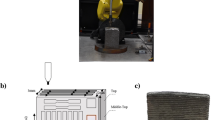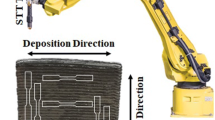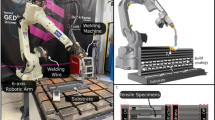Abstract
Among metal-based additive manufacturing, wire and arc additive manufacturing is receiving increasing attention for the production of components with medium to large dimensions. In the current research, the production of low-carbon steel thin-walled components by wire and arc additive manufacturing was addressed. Firstly, the influence of two depositing direction strategies on the wall shape was investigated. Subsequently, the effect of heat input on the shape stability and the microstructure evolution of the walls was studied. The results indicated that the alternating depositing direction strategy was more suited to build thin walls with relatively regular height. The heat input significantly influenced the shape stability, but had slight effects on the microstructure evolution. The microstructure of the walls varied from the top to the bottom regions, leading to a variation in hardness from 157 ± 3.11 to 192 ± 4.30 (HV5). The microstructure of the built thin walls can be distinguished in three regions: The upper region exhibited lamellar structures; the middle region dominantly featured granular structures of ferrites with a small proportion of pearlites, which appear in the boundaries of grains; and the lower region showed a mix of lamellar and equiaxed structures of ferrites. The tensile properties of the built material also exhibited anisotropic characteristics: The yield strength and ultimate tensile strength vary from 320 ± 6 to 362 ± 8 MPa and from 429 ± 8 to 479 ± 7 MPa, respectively.










Similar content being viewed by others
Availability of data and materials
All data generated or analyzed during this study are included in this published article.
References
Guo N, Leu M (2013) Additive manufacturing: technology, applications and research needs. Front Mech Eng 8:215–243. https://doi.org/10.1007/s11465-013-0248-8
Le VT, Paris H, Mandil G (2017) Environmental impact assessment of an innovative strategy based on an additive and subtractive manufacturing combination. J Clean Prod 164:508–523. https://doi.org/10.1016/j.jclepro.2017.06.204
Le VT, Paris H (2018) A life cycle assessment-based approach for evaluating the influence of total build height and batch size on the environmental performance of electron beam melting. Int J Adv Manuf Technol 98:275–288. https://doi.org/10.1007/s00170-018-2264-7
Huang S, Liu P, Mokasdar A, Hou L (2013) Additive manufacturing and its societal impact: a literature review. Int J Adv Manuf Technol 67:1191–1203. https://doi.org/10.1007/s00170-012-4558-5
Arcam AB Corporation n.d. http://www.arcam.com/
Williams SW, Martina F, Addison AC, Ding J, Pardal G, Colegrove P (2016) Wire + Arc additive manufacturing. Mater Sci Technol 32:641–647. https://doi.org/10.1179/1743284715Y.0000000073
Ding D, Pan Z, Cuiuri D, Li H (2015) Wire-feed additive manufacturing of metal components: technologies, developments and future interests. Int J Adv Manuf Technol 81:465–481. https://doi.org/10.1007/s00170-015-7077-3
Buchanan C, Gardner L (2019) Metal 3D printing in construction: a review of methods, research, applications, opportunities and challenges. Eng Struct 180:332–348. https://doi.org/10.1016/j.engstruct.2018.11.045
Pires JN, Loureiro A, Bölmsjo G (2006) Welding robots: technology, system issues and application. Springer, London. https://doi.org/10.1007/1-84628-191-1
Zhang Z, Sun C, Xu X, Liu L (2018) Surface quality and forming characteristics of thin-wall aluminium alloy parts manufactured by laser assisted MIG arc additive manufacturing. Int J Light Mater Manuf 1:89–95. https://doi.org/10.1016/j.ijlmm.2018.03.005
Dinovitzer M, Chen X, Laliberte J, Huang X, Frei H (2019) Effect of wire and arc additive manufacturing (WAAM) process parameters on bead geometry and microstructure. Addit Manuf 26:138–146. https://doi.org/10.1016/j.addma.2018.12.013
Waqas A, Qin X, Xiong J, Wang H, Zheng C (2019) Optimization of process parameters to improve the effective area of deposition in GMAW-based additive manufacturing and its mechanical and microstructural analysis. Metals (Basel) 9:775. https://doi.org/10.3390/met9070775
Yang D, Wang G, Zhang G (2017) Thermal analysis for single-pass multi-layer GMAW based additive manufacturing using infrared thermography. J Mater Process Technol 244:215–224. https://doi.org/10.1016/j.jmatprotec.2017.01.024
Abe T, Sasahara H (2019) Layer geometry control for the fabrication of lattice structures by wire and arc additive manufacturing. Addit Manuf 28:639–648. https://doi.org/10.1016/j.addma.2019.06.010
Xiong J, Lei Y, Chen H, Zhang G (2017) Fabrication of inclined thin-walled parts in multi-layer single-pass GMAW-based additive manufacturing with flat position deposition. J Mater Process Technol 240:397–403. https://doi.org/10.1016/j.jmatprotec.2016.10.019
Xiong J, Li Y, Li R, Yin Z (2018) Influences of process parameters on surface roughness of multi-layer single-pass thin-walled parts in GMAW-based additive manufacturing. J Mater Process Technol 252:128–136. https://doi.org/10.1016/j.jmatprotec.2017.09.020
Hu Z, Qin X, Li Y, Yuan J, Wu Q (2019) Multi-bead overlapping model with varying cross-section profile for robotic GMAW-based additive manufacturing. J Intell Manuf. https://doi.org/10.1007/s10845-019-01501-z
Xiong J, Zhang G (2014) Adaptive control of deposited height in GMAW-based layer additive manufacturing. J Mater Process Technol 214:962–968. https://doi.org/10.1016/j.jmatprotec.2013.11.014
Yang D, He C, Zhang G (2016) Forming characteristics of thin-wall steel parts by double electrode GMAW based additive manufacturing. J Mater Process Technol 227:153–160. https://doi.org/10.1016/j.jmatprotec.2015.08.021
Zhao H, Zhang G, Yin Z, Wu L (2013) Effects of interpass idle time on thermal stresses in multipass multilayer weld-based rapid prototyping. J Manuf Sci Eng 135:011016. https://doi.org/10.1115/1.4023363
Ortega AG, Corona Galvan L, Salem M, Moussaoui K, Segonds S, Rouquette S et al (2019) Characterisation of 4043 aluminium alloy deposits obtained by wire and arc additive manufacturing using a cold metal transfer process. Sci Technol Weld Join 24:538–547. https://doi.org/10.1080/13621718.2018.1564986
Gokhale NP, Kala P, Sharma V (2019) Thin-walled metal deposition with GTAW welding-based additive manufacturing process. J Braz Soc Mech Sci Eng 41:569. https://doi.org/10.1007/s40430-019-2078-z
Silva CMA, Bragança IMF, Cabrita A, Quintino L, Martins PAF (2017) Formability of a wire arc deposited aluminium alloy. J Braz Soc Mech Sci Eng 39:4059–4068. https://doi.org/10.1007/s40430-017-0864-z
Derekar KS (2018) A review of wire arc additive manufacturing and advances in wire arc additive manufacturing of aluminium. Mater Sci Technol 34:895–916. https://doi.org/10.1080/02670836.2018.1455012
Wu B, Pan Z, Ding D, Cuiuri D, Li H, Xu J et al (2018) A review of the wire arc additive manufacturing of metals: properties, defects and quality improvement. J Manuf Process 35:127–139. https://doi.org/10.1016/j.jmapro.2018.08.001
Islam T, Rashed HMMA (2019) Classification and application of plain carbon steels, vol 2. Elsevier, Amsterdam. https://doi.org/10.1016/B978-0-12-803581-8.10268-1
Greer C, Nycz A, Noakes M, Richardson B, Post B, Kurfess T et al (2019) Introduction to the design rules for metal big area additive manufacturing. Addit Manuf 27:159–166. https://doi.org/10.1016/j.addma.2019.02.016
Laghi V, Palermo M, Gasparini G, Girelli VA, Trombetti T (2019) Experimental results for structural design of wire-and-arc additive manufactured stainless steel members. J Constr Steel Res. https://doi.org/10.1016/j.jcsr.2019.105858
MX3D. MX3D Bridge n.d. www.mx3d.com
Haden CV, Zeng G, Carter FM, Ruhl C, Krick BA, Harlow DG (2017) Wire and arc additive manufactured steel: tensile and wear properties. Addit Manuf 16:115–123. https://doi.org/10.1016/j.addma.2017.05.010
Rafieazad M, Ghaffari M, Vahedi Nemani A, Nasiri A (2019) Microstructural evolution and mechanical properties of a low-carbon low-alloy steel produced by wire arc additive manufacturing. Int J Adv Manuf Technol 105:2121–2134. https://doi.org/10.1007/s00170-019-04393-8
Lin Z, Goulas C, Ya W, Hermans MJM (2019) Microstructure and mechanical properties of medium carbon steel deposits obtained via wire and arc additive manufacturing using metal-cored wire. Metals (Basel). https://doi.org/10.3390/met9060673
Welding Handbook, KOBE STEEL, LTD. n.d
Quintino L, Liskevich O, Vilarinho L, Scotti A (2013) Heat input in full penetration welds in gas metal arc welding (GMAW). Int J Adv Manuf Technol 68:2833–2840. https://doi.org/10.1007/s00170-013-4862-8
Xiong J, Yin Z, Zhang W (2016) Forming appearance control of arc striking and extinguishing area in multi-layer single-pass GMAW-based additive manufacturing. Int J Adv Manuf Technol 87:579–586. https://doi.org/10.1007/s00170-016-8543-2
Wu Q, Ma Z, Chen G, Liu C, Ma D, Ma S (2017) Obtaining fine microstructure and unsupported overhangs by low heat input pulse arc additive manufacturing. J Manuf Process 27:198–206. https://doi.org/10.1016/j.jmapro.2017.05.004
Liberini M, Astarita A, Campatelli G, Scippa A, Montevecchi F, Venturini G et al (2017) Selection of optimal process parameters for wire arc additive manufacturing. Proc CIRP 62:470–474. https://doi.org/10.1016/j.procir.2016.06.124
Singh KK, Sangal S, Murty GS (2002) Hall-Petch behaviour of 316L austenitic stainless steel at room temperature. Mater Sci Technol 18:165–172. https://doi.org/10.1179/026708301125000384
Yan JB, Liew JYR, Zhang MH, Wang JY (2014) Mechanical properties of normal strength mild steel and high strength steel S690 in low temperature relevant to arctic environment. Mater Des 61:150–159. https://doi.org/10.1016/j.matdes.2014.04.057
Funding
This research is funded by Vietnam National Foundation for Science and Technology Development (NAFOSTED) under Grant Number 107.99-2019.18.
Author information
Authors and Affiliations
Contributions
VTL proposed and designed the study. VTL, DSM, and QHH performed the experiments. VTL wrote the manuscript. All authors read, edited, and approved the final manuscript.
Corresponding author
Ethics declarations
Conflict of interest
The authors declare that they have no competing interests.
Additional information
Technical Editor: Lincoln Cardoso Brandao.
Publisher's Note
Springer Nature remains neutral with regard to jurisdictional claims in published maps and institutional affiliations.
Rights and permissions
About this article
Cite this article
Le, V.T., Mai, D.S. & Hoang, Q.H. A study on wire and arc additive manufacturing of low-carbon steel components: process stability, microstructural and mechanical properties. J Braz. Soc. Mech. Sci. Eng. 42, 480 (2020). https://doi.org/10.1007/s40430-020-02567-0
Received:
Accepted:
Published:
DOI: https://doi.org/10.1007/s40430-020-02567-0




